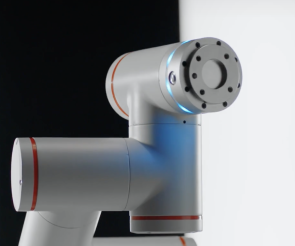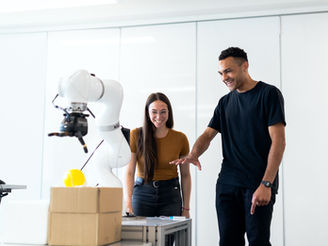top of page
Latest
Search


How Blue Sky Robotics Uses Human-Centered Design for Automation Solutions
Robotics is transforming industries of every scale. From manufacturing to logistics to custom fabrication, automated systems are no longer limited to massive factories with multimillion-dollar budgets. Today, small and midsize businesses are exploring robotics as a way to increase efficiency, reduce errors, and stay competitive. But the true breakthrough isn’t simply about adding more machines, it’s about designing automation that works with people, not around them.
5 min read


Why Cobots Are the Future of Pick and Place Operations
Pick and place operations have long been a bottleneck in fast-paced warehouse environments. This blog explores how cobots—paired with modern end effectors—are helping operations meet demand without overburdening human labor. We cover how cobots excel at repetitive motion, vision-guided alignment, and multi-shift operations while still being safe around workers. From box handling to small parts, learn how cobots can handle the nuances of diverse workflows and why the ROI is so
2 min read


From Manual to Cobot: How Small Warehouses Are Making the Leap
Smaller warehouses often face staffing shortages, tight budgets, and increasing order volumes. Collaborative robots—or cobots—offer a scalable and affordable automation solution. This blog highlights how even modest operations are using cobots to streamline processes like picking, kitting, and packing. With lower upfront costs, intuitive programming, and safety features that enable human-robot collaboration, cobots make it easy for small teams to scale output without sacrific
2 min read


Cobots in the Warehouse: Collaborative Robots Boosting Efficiency
Cobots, or collaborative robots, are transforming warehouse operations by working safely alongside humans to boost efficiency and safety. Unlike traditional warehouse robots, cobots handle repetitive tasks like picking, packing, and transport, allowing workers to focus on higher-value work. Ideal for flexible, scalable automation, cobots are a key part of the modern robotics warehouse, improving productivity while reducing injuries and operational costs.
4 min read


UFactory xArm Review: Best Models and Solutions for Small Manufacturers
Small manufacturers face challenges in adapting automation technology to meet production demands without prohibitive costs. The UFactory xArm is a versatile robotic solution designed specifically for small-scale manufacturing operations. This review explores its key features, model comparisons, efficiency improvements, and real-world applications. It provides insights into how the xArm can be integrated into existing workflows to boost productivity and reduce operational cost
7 min read


What Is a Welding Cobot and When Should You Use One?
Welding cobots—collaborative robots built for welding—are revolutionizing industrial automation by combining precision, safety, and efficiency. Designed to work alongside humans, they automate repetitive welding tasks, reduce errors, and improve workplace safety. Ideal for high-mix or high-volume environments, welding cobots offer fast ROI and seamless integration into existing production lines, making them an essential tool for modern manufacturing.
7 min read


End Effectors for Robots: Comprehensive Guide to Grippers, Tools, and Best Use Cases
In today’s competitive manufacturing landscape, the demand for enhanced efficiency, precision, and reliability in small part assembly is higher than ever. Businesses must optimize production lines (by exploring solutions from Blue Sky Robotics, for example) reduce costs, and ensure workplace safety. Collaborative robots—commonly termed cobots—offer a transformative solution by integrating sensor technology, artificial intelligence, and machine vision to work alongside human o
8 min read


Is a KUKA Robot Worth the Investment? Price Breakdown Explained
The price of a KUKA robot depends on its model, payload capacity, and required customization. In many projects, integration with blue sky robotics can enhance overall performance and flexibility. KUKA offers robots for various tasks—from light assembly to heavy-duty welding and palletizing—with costs rising as technical specifications such as higher payload capacities, extended reach, and robust motors and sensors are required.
8 min read


Pricing Breakdown: How Much Do Cobot Capable Robots Cost in 2025?
At Blue Sky Robotics, we’re focused on helping small to midsize businesses unlock affordable automation. Since our software is robot-agnostic, we support a wide range of cobot capable robots, so you can build the solution that best fits your workflow.
2 min read


Affordable Robotic Arms: How Advanced Manufacturing and Streamlined Supply Chains Are Revolutionizing Robotics
In recent years, the robotics industry has undergone a remarkable transformation, making robotic arms more affordable and accessible than ever before. This breakthrough is primarily driven by advancements in manufacturing technologies and a streamlined supply chain that cuts costs without compromising quality. Affordable robotic arms are now empowering small and medium-sized businesses across diverse industries—from automotive and electronics to consumer goods and healthcare.
5 min read


Essential Cobot Accessories That Maximize Performance
Collaborative robots, or cobots, are transforming modern manufacturing—but it’s the cobot accessories that often determine how effective and versatile your robotic setup really is. From end of arm tooling (EOAT) to mounting hardware, the right components can dramatically expand your automation capabilities. In this article, we’ll explore the most critical cobot accessories and how they enhance your robot’s performance across industries.
2 min read


End Effector Types Explained: Choosing the Right Robotic EOAT for Your Application
In modern automation, selecting the right robot end effector can make or break the performance of your robotic system. Often referred to as robotic EOAT (End of Arm Tooling), end effectors are the tools attached to the end of a robot arm that interact with the environment to perform tasks like gripping, welding, cutting, or moving parts. But not all end effector types are created equal. Below, we break down common end effector types, their best applications, and real-world us
2 min read


Revolutionizing the Industry: How Paint Robots Are Transforming Robotic Painting
Robotic painting boosts precision, efficiency, and safety in manufacturing. Used across industries like automotive and aerospace, these systems reduce waste, cut costs, and deliver high-quality finishes.
5 min read


Introduction to Robotic Process Automation (RPA): Unlocking Efficiency in the Digital Age
In today's fast-paced business environment, organizations are under constant pressure to do more with less. One of the most...
3 min read


NSF Food-Safe Robots Transform the Food Industry
Food-safe robots, also known as hygienic robots or washdown robots, are revolutionizing how food is handled in manufacturing, hospitality, and healthcare settings. These robots are engineered with food-grade materials, smooth surfaces, and sealed designs that withstand rigorous cleaning, allowing them to operate in direct contact with food without harboring bacteria.
4 min read


Reinventing Daily Operations with Cobot Capable Robots
Collaborative robots (cobot capable robots) are reshaping work across industries by blending flexibility, precision, and ease of use. No longer limited to simple tasks, modern cobots adapt to changing workflows, require minimal setup, and empower workers by reducing strain and increasing efficiency. As AI advances, these smart, user-friendly systems are becoming essential tools in creating smarter, more agile workplaces.
2 min read


Why Cobot Capable Robots Are the Future of Flexible Automation
Cobot capable robots are transforming the workplace by working safely alongside people—no cages, no complex programming. Lightweight, flexible, and AI-powered, these collaborative robots handle repetitive or delicate tasks with precision, making automation accessible to businesses of all sizes. From warehouses to labs, cobots enhance human productivity and enable smarter, safer workflows.
2 min read


Debunking Common Automation Myths: Part 3
Manual systems often conceal high error rates and costly inefficiencies. Even a 1% data entry error rate can lead to recalls, defects, or lost revenue. In 2023 alone, labeling mistakes caused 50% of U.S. food and beverage recalls — with an average cost of $10 million per recall.
11 min read


Collaborative Robotic Arm Cost Breakdown by Payload Class (2025)
The cost of cobot arms can range greatly, and much of the excess cost can be attributed to how much payload the robotic arm is cleared to carry. Here are the a few of the latest collaborative robotic arms on the market right now and their respective weight categories.
2 min read


Buying Robotic Arms: Best Collaborative Robots of 2025 for Small Manufacturers
As collaborative robots become more accessible, 2025 is shaping up to be a breakout year for small manufacturers automating repetitive tasks. Whether you’re exploring your first deployment or looking to expand your robotic cell, choosing the best robotic arm depends on your application, environment, and support needs.
Here’s a breakdown of the top collaborative robotic arms of 2025, focused on usability, integration, and ROI.
3 min read
bottom of page






